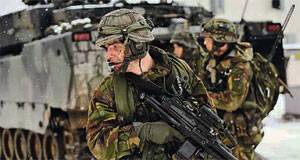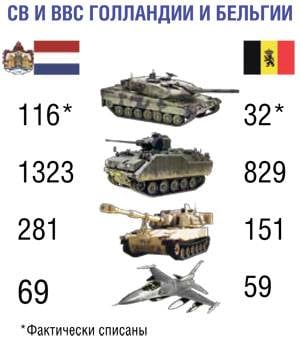NATO crowd
At the beginning of 1990, they included 913 tanks, 1467 BBM, 838 artillery systems, 196 combat aircraft, 91 attack helicopters. After the dissolution of the Warsaw Pact and the collapse of the USSR, the Dutch, like all other NATO armies, switched from conscription to the hired principle of manning. The sun has undergone significant reductions, which continue to this day. The troops are now purely expeditionary in nature. They are designed for counterguerrilla and peacekeeping operations in developing countries as part of international coalitions.
Ground forces include the 13 th light, 43 th mechanized and 11 th airmobile brigades, as well as the command of support.
The country formally remains 116 tanks - 105 "Leopard-2" and 11 "Leopard-1". However, all of them were withdrawn from combat units and are in warehouses, waiting for either sales abroad (mostly to Finland), or conversion into engineering vehicles (BREM or tank bridge laying systems).
In connection with the withdrawal of the tanks, the most powerful combat vehicles of the Dutch army are the BMP - 139 of the Swedish CV9035 and 40 own YPR-765 with the 25-mm gun. Armored vehicles and armored personnel carriers: 391 own YPR-765, 5 Finnish HA-188, 76 Australian Bushmaster, 65 Swedish BVS-10, 365 German-Dutch Fennec. Plus 200 auxiliary machines on the chassis of the BTR "Boxer".
Artillery has 59 ACS (56 newest German PzH-2000, 3 old American M-109) and 222 French Brandt mortars. There is an Israeli Spike 297.
Ground defense includes 3 batteries (9 PU) of the Norwegian-American NASAMS and 72 air defense systems of the US Stinger self-propelled anti-aircraft missiles (2 man-portable air defense systems on Fennek 18 and 18 vehicles).
The Dutch Air Force is armed with X-NUMX F-69 fighter-bombers. In the coming 16 years it is supposed to replace the F-10 with the 16 F-37А fighter jets, two of which have already been formally transferred to the Dutch Air Force and are being tested in the United States. In addition, the Air Force has 35 German basic patrol aircraft Do-2, 228, KDC-2 and 10 transport aircraft (5 C-4H-130, 30 "Gulf Stream-1", all made in the USA, 4 Swiss training PC-13.
Holland is one of three European countries that have US AH-64D Apache combat helicopters in service - 26 aircraft. Anti-submarine aviation includes 15 NH-90. Multipurpose and transport helicopters - 11 AS532, 17 SN-47.
Ground defense consists of X-NUMX batteries Patrik "Patriot", 4 PU.
On the territory of Holland (VVB “Volkel”) are stored 22 nuclear bombs ВХNUMX, designed for the Dutch air force itself in case of a large-scale war in Europe.
IUDs are composed 4 submarine type "Valrus", 4 frigate "7 provinces" (sometimes they are classified as destroyers), 2 frigate "Karel Doorman", 4 patrol ship "Holland", 6 minesweepers "AZ", 2 DVKD "Rotterdam" . Everything is built in Holland itself, but the weapons are foreign.
Marines include the 2 battalion.
The capital of Belgium - Brussels is, as is known, part-time the capital of Europe: it is here that the headquarters of NATO and the European Union are located. At the same time Belgium itself is permanently on the verge of collapse. Its two main parts - Flanders and Wallonia, in fact, exist as independent states, and Brussels has a special status both in Belgium itself and in Europe.
At the beginning of the 90-s of the Belgian Armed Forces had 360 tanks, about 1400 BMP and BTR, 400 artillery systems, 200 combat aircraft. Today, this force has become almost imperceptible.
 The Belgian Land Forces include a medium and light brigade (the MTR group is part of the light), the 2 artillery regiment.
The Belgian Land Forces include a medium and light brigade (the MTR group is part of the light), the 2 artillery regiment.The tank fleet formally includes the outdated “Leopard-32” 1, but in reality they are withdrawn from service and intended for disposal or sale. There are 41 Austrian BRM “Pandur” and 19 auxiliary vehicles on its base, 440 Italian armored vehicles LMV and 158 German “Dingo-2”, 41 BTR YPR-765, 171 Swiss BTR “Piran 3”
Belgian artillery has really 17 105-mm guns (3 M-101, 14 LG1 Mk2), 32 mortar RTF1, 42 М1, 60 М19. There is a 11 self-propelled Milan-guided missile system "Milan" on the YPR-765 chassis.
The entire Belgian ground defense consists of 45 French Mistral MANPADS.
The Belgian Air Force includes the X-NUMX F-59 fighter-bombers, the 16 transport vehicles (18 C-11H, 130 ERJ-2 LR, 135 ERJ-2 LR, 145 "Falcon-1", 20 "FNCX-NNXX-RNX-XRUMX, 1" Falcon-900 ", 1 ERN-321 LR, 61" Falcon-32 ", 260" Falcon-NIX; 29 training aircraft (37 SF-3D / M, 23 "Alpha Jet") and 109 helicopters (3 anti-submarine "Sea King", 316 multipurpose A-8 and 90 SA20, 61 transport NH16). The Klein Brogel WWB stores the XNUMX of the US nuclear bombs B-XNUMX, which in the event of war will be used with the F-XNUMX of the Belgian Air Force.
Navy countries have the 2 frigate "Leopold" (a Dutch-built type "Karel Doorman"), 2 unarmed patrol ships "Castor" and 6 minesweepers "Tpartit".
 The army of the microstate of Luxembourg is purely symbolic. In fact, it exists only to personify the country's membership in NATO.
The army of the microstate of Luxembourg is purely symbolic. In fact, it exists only to personify the country's membership in NATO.The ground forces consist of a light infantry battalion (4 company) and two reconnaissance platoons. Armed with 48 armored vehicles "Dingo-2", 6 English mortar L16 and 6 American ATGM "Tou".
The Air Force has no Luxembourg. X-NUMX E-16A DRLO and 3 training CT-3 ("Boeing-49") aircraft are purely formally assigned to them. In fact, they belong to the United States Air Force, transferred to NATO and stationed in Germany on the Heilenkirchen High Air Force. These are the only generalized vehicles and crews, all other parts, formations and armaments of the alliance belong to specific countries. Airplanes appear for Luxembourg only in order to imitate the presence of the Air Force.
On the whole, the Benelux armies are capable of purely symbolic participation in the police and peacekeeping operations of NATO and the UN and do not at all ensure the defense of their own states. However, there is no one to attack them not only today, but in any foreseeable future. The threat comes from within; the army will not be saved from it anyway. To discuss any prospects and trends in the development of the Benelux armies is completely pointless due to the absence of such.
Information